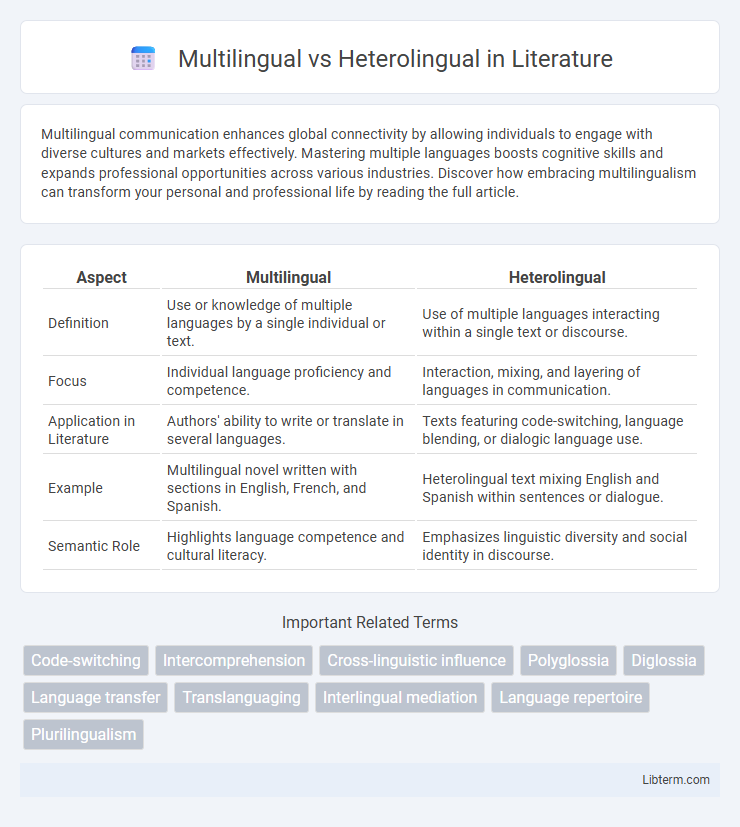Multilingual communication enhances global connectivity by allowing individuals to engage with diverse cultures and markets effectively. Mastering multiple languages boosts cognitive skills and expands professional opportunities across various industries. Discover how embracing multilingualism can transform your personal and professional life by reading the full article.
Table of Comparison
| Aspect | Multilingual | Heterolingual |
|---|---|---|
| Definition | Use or knowledge of multiple languages by a single individual or text. | Use of multiple languages interacting within a single text or discourse. |
| Focus | Individual language proficiency and competence. | Interaction, mixing, and layering of languages in communication. |
| Application in Literature | Authors' ability to write or translate in several languages. | Texts featuring code-switching, language blending, or dialogic language use. |
| Example | Multilingual novel written with sections in English, French, and Spanish. | Heterolingual text mixing English and Spanish within sentences or dialogue. |
| Semantic Role | Highlights language competence and cultural literacy. | Emphasizes linguistic diversity and social identity in discourse. |
Understanding Multilingual and Heterolingual: Definitions
Multilingual refers to the ability of an individual or community to use and understand multiple languages proficiently, often switching between them based on context. Heterolingual describes the presence and interaction of different languages within a single text or communication, highlighting the coexistence and interplay of diverse linguistic elements. Understanding these terms clarifies how language skills and multilingual environments function distinctly in linguistic and sociocultural contexts.
Historical Context: Evolution of Language Use
Multilingualism historically emerged as communities and empires expanded, facilitating communication across distinct linguistic groups through the coexistence of multiple languages within a society. Heterolingualism, by contrast, reflects layered language use where different languages serve specialized functions, often shaped by colonial, administrative, or social hierarchies. The evolution of language use in these contexts reveals complex sociopolitical dynamics influencing language maintenance, shift, and the development of diglossia or code-switching practices.
Core Differences Between Multilingualism and Heterolingualism
Multilingualism refers to the ability of an individual or community to use multiple languages proficiently, whereas heterolingualism emphasizes the simultaneous presence of different languages within a social or communicative context without necessarily implying mastery of each. Core differences focus on the individual's language proficiency in multilingualism versus the interaction and coexistence of languages in heterolingualism, highlighting sociolinguistic dynamics rather than linguistic competence. Multilingualism centers on language acquisition and use, while heterolingualism addresses code-switching, language contact, and hybrid communication forms within diverse speech communities.
Sociolinguistic Perspectives on Multilingual vs Heterolingual
Multilingual societies feature individuals proficient in multiple languages used in distinct contexts, while heterolingualism emphasizes the fluid, dynamic interplay of languages within social interactions. Sociolinguistic perspectives highlight that multilingualism often involves compartmentalized language use based on domains, whereas heterolingualism reflects a more integrated, hybrid linguistic practice shaping identity and power relations. Understanding these distinctions provides deeper insights into language contact phenomena, code-switching, and the sociocultural dimensions of language use in diverse communities.
Cognitive Impacts: Learning Multiple Languages
Multilingualism enhances cognitive flexibility by engaging distinct neural networks associated with separate languages, while heterolingualism involves using mixed language forms, leading to unique cognitive control demands. Studies show multilingual individuals often exhibit improved executive functions, such as problem-solving and attention switching, whereas heterolingual speakers may develop heightened sensitivity to context-dependent language cues. Both language experiences foster neuroplasticity but differ in how bilingual brains manage linguistic interference and code-switching processes.
Multilingualism in Education Systems Worldwide
Multilingualism in education systems worldwide fosters cognitive flexibility and cultural awareness among students by incorporating instruction in multiple languages, promoting inclusive learning environments that reflect diverse linguistic backgrounds. Countries like Canada, India, and Switzerland implement multilingual curricula to enhance communication skills and global competitiveness, supporting minority language preservation alongside dominant languages. Emphasizing multilingual education helps prepare learners for interconnected global contexts by developing proficiency in several languages and appreciating linguistic diversity.
Heterolingualism in Literature and Media
Heterolingualism in literature and media highlights the dynamic use of multiple languages within a single text or discourse, reflecting authentic cultural and social interactions. Unlike multilingualism, which simply denotes the presence of several languages, heterolingualism emphasizes the strategic interplay and code-switching between languages, enriching narrative complexity and audience engagement. This linguistic hybridity is prominent in contemporary postcolonial and diasporic literature and media, where authors and creators challenge monolingual norms to represent diverse identities and realities.
Challenges and Opportunities in Multilingual versus Heterolingual Communities
Multilingual communities, where individuals speak multiple languages but maintain distinct linguistic boundaries, face challenges such as communication barriers and social segregation, yet offer opportunities for cross-cultural understanding and economic advantages in global markets. Heterolingual communities, characterized by frequent code-switching and language mixing, present complexities in language preservation and identity negotiation, while fostering dynamic linguistic innovation and deeper social cohesion. Addressing education policies and language planning in both contexts can enhance integration and cultural vitality.
Policy Implications: Language Planning and Rights
Multilingual policies prioritize the coexistence and equal recognition of multiple languages within a community to promote inclusivity and protect linguistic rights, often requiring comprehensive language planning to support education, public services, and official communication. Heterolingual contexts emphasize functional language use based on domain-specific needs, which can lead to selective language promotion and sometimes marginalization of less dominant languages, impacting language rights and access to resources. Effective language policy must balance these approaches by ensuring equitable language rights while addressing practical language use, thereby fostering social cohesion and preventing linguistic discrimination.
Future Trends: The Globalization of Language Practices
Future trends in language practices emphasize a shift from traditional multilingualism, characterized by the coexistence of separate languages, toward heterolingualism, which integrates multiple languages and dialects within dynamic communicative contexts. Digital globalization facilitates heterolingual interactions, enabling seamless code-switching and language blending across social media, education, and international business. This evolution points to a more fluid, hybridized global linguistic landscape where language boundaries become increasingly porous and functional multilingual competence is prioritized.
Multilingual Infographic

 libterm.com
libterm.com